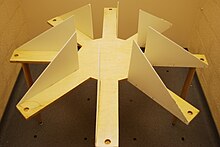
The radial arm maze was designed by Olton and Samuelson in 1976 to measure spatial learning and memory in rats.[1] The original apparatus consists of eight equidistantly spaced arms, each about 4 feet long, and all radiating from a small circular central platform (later versions have used as few as three[2] and as many as 48 arms[3]). At the end of each arm there is a food site, the contents of which are not visible from the central platform.
Two types of memory that are assessed during the performance in this task are reference memory and working memory. Reference memory is assessed when the rats only visit the arms of the maze which contains the reward. The failure to do so will result in reference memory error. Working memory is assessed when the rats enter each arm a single time. Re-entry into the arms would result in a working memory error.[4]
The design ensures that, after checking for food at the end of each arm, the rat is always forced to return to the central platform before making another choice. As a result, the rat always has eight possible options. Elaborate controls are used to ensure that the rats are not simply using their sense of smell, either to sense unclaimed food objects or to sense their own tracks.
Olton and Samuelson found that rats have excellent memories for visited and unvisited arms; they made, on average, about 7.0 novel entries in their first 8 choices, and thus were 88% correct.[1] Chance performance with eight arms would be 5.3 novel entries in the first 8 choices (66% correct). Olton and Samuelson also found when they switched some already-visited arms into as yet unvisited locations partway through a trial, that the rats tended to visit as-yet unvisited locations even when doing so meant running down arms that had already been traversed, and tended to avoid arms that had not yet been traversed but were now in previously visited locations.[1] It therefore seems that in remembering locations on the radial arm maze, rats do not rely on local intra-maze cues, but rather on extra-maze cues.
- ^ a b c Olton, D.S.; Samuelson, R.J. (1976). "Remembrance of places passed: Spatial memory in rats". Journal of Experimental Psychology: Animal Behavior Processes. 2 (2): 97–116. doi:10.1037/0097-7403.2.2.97.
- ^ Lenck-Santini PP, Save E, Poucet B (2001). "Place-cell firing does not depend on the direction of turn in a Y-maze alternation task". Eur J Neurosci. 13 (5): 1055–8. doi:10.1046/j.0953-816x.2001.01481.x. PMID 11264680. S2CID 30940014.
- ^ Cole, M.R.; Chappell-Stephenson, Robyn (2003). "Exploring the limits of spatial memory using very large mazes". Learning & Behavior. 31 (4): 349–368. doi:10.3758/BF03195996. PMID 14733483.
- ^ E. Tarragon, L. Lopez, F. Ros-Bernal, J.E. Yuste, V. Ortiz-Cullera, E. Martin, E. Schenker, F. Aujard, R.Bordet, J.C. Richardson, M.T. Herrero, "The Radial Arm Maze (RAM) for the Evaluation of Working and Reference Memory Deficits in the Diurnal Rodent Octodon degus." Proceedings of Measuring Behavior 2012 (Utrecht, The Netherlands, August 28-31, 2012).